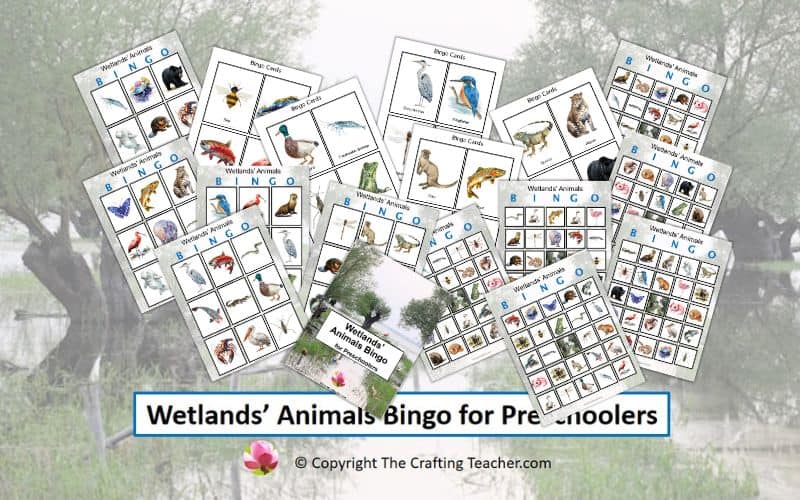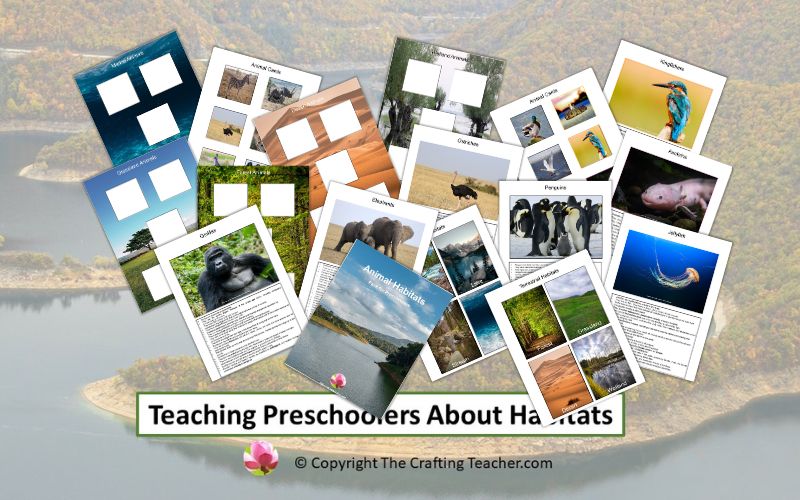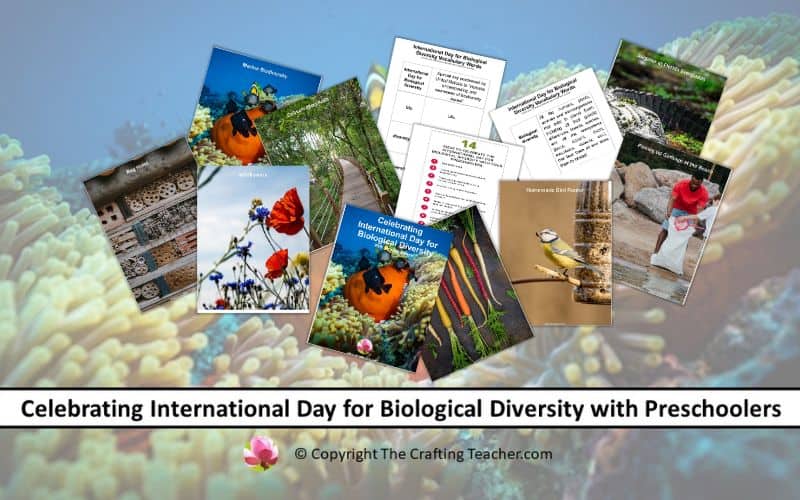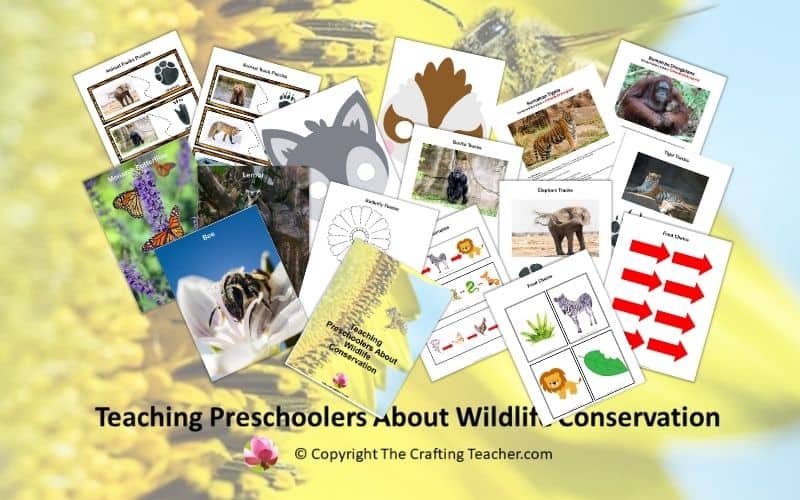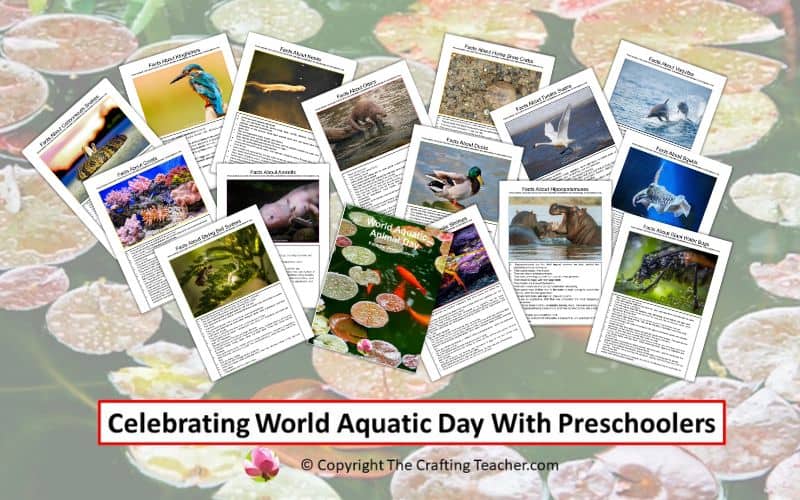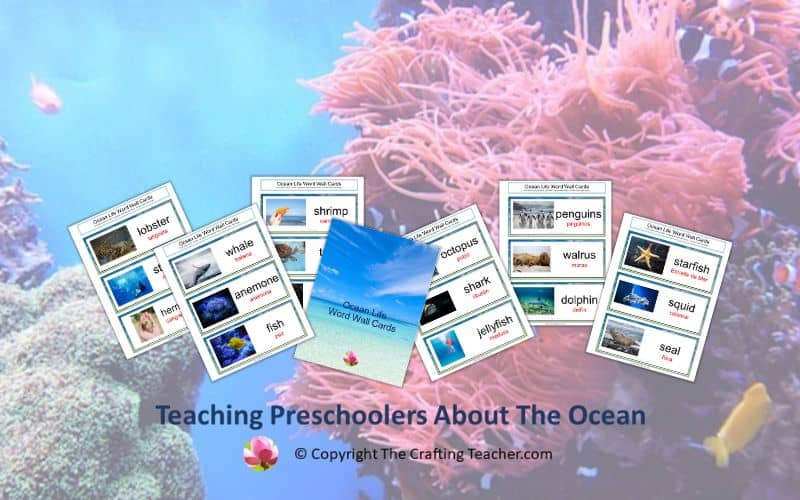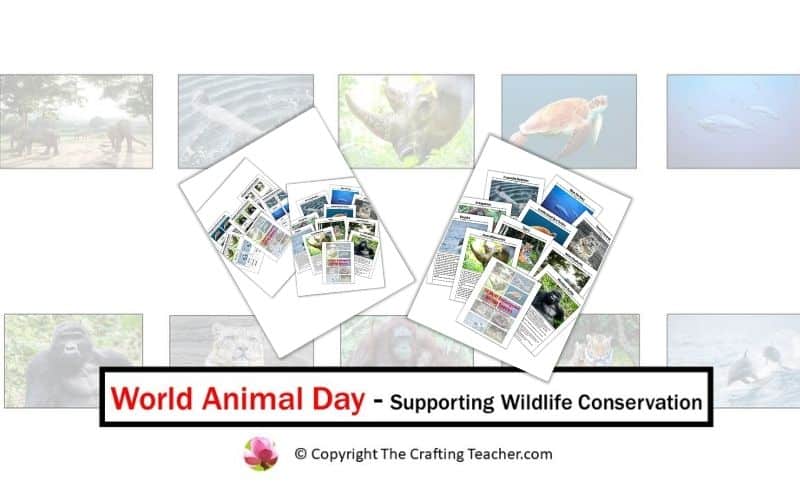Wetlands’ Animals Bingo for Preschoolers
Affiliate Disclosure: “This post contains affiliate links, which means I receive a small commission, at no extra cost to you, if you make a purchase using those links.”
World Wetlands Day is celebrated on February 2nd each year to raise global awareness about the vital role of wetlands for people and our planet. This FREE Wetlands’ Animals Bingo could be a great activity to keep them entertained and focused while developing essential skills after you teach your preschoolers about wetlands and some animals living in these habitats.
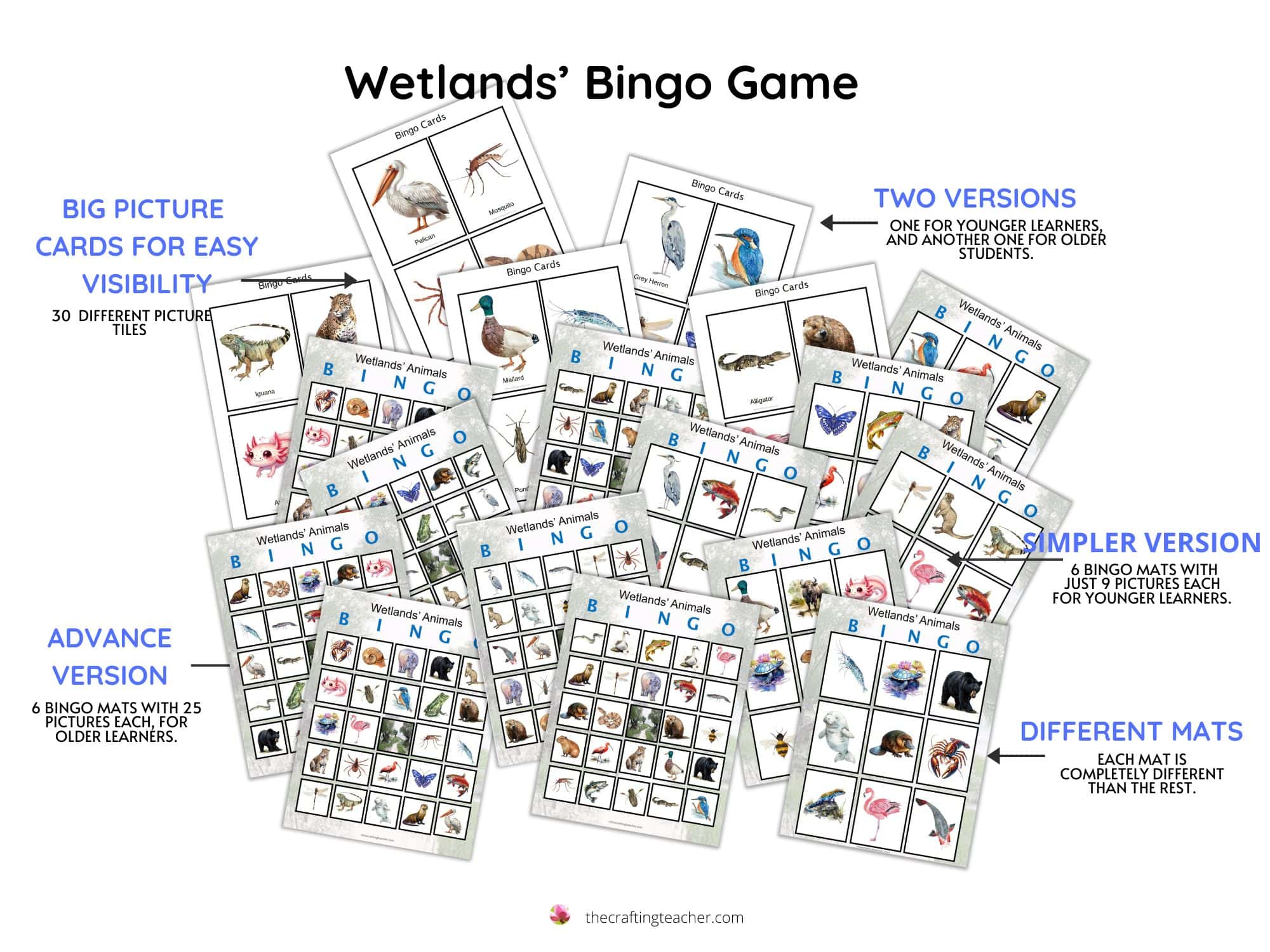
This bingo printable includes two versions with six pages each, one for younger learners and another for more advanced learners. Each card of the simpler version includes nine pictures. The advanced version also consists of 24 pictures on each card. I also included 40 picture cards to show the children which pictures they should mark on their bingo cards. You can get it at the end of this post.
What are Wetlands?
Wetlands are areas where soil is saturated or flooded with water permanently or seasonally. These areas are among the most critical ecosystems in the world for an immense variety of species of plants, microorganisms, insects, birds, fish, amphibians, and mammals, including many threatened and endangered species.
Wetlands provide many essential benefits to animals and people, such as:
- Help to control global climate conditions.
- Provide fresh water and improve its quality.
- Protect against floods and shoreline erosion.
- Provide significant volumes of food, water, and shelter for many species of animals that use wetlands during migration, breeding, or all of their life cycle.
- Their fauna and flora are key components of global cycles for water, nitrogen, sulfur, and carbon storage.
- Provide free recreational activities for humans and natural products such as fish, shellfish, blueberries, cranberries, and wild rice.
- Some wetlands’ soil and plants provide ingredients for some medicines.
- Some commercial products are made with wetland animals’ fur and skin, such as alligators, muskrats, beavers, and mink.
There are different types of wetlands:
- Inland wetlands include marshes, bogs, ponds, fens, riverine, floodplains, and swamps.
- Coastal wetlands include estuaries, mangroves, lagoons, and coral reefs.
- Human-made wetlands such as fish ponds, rice paddies, and saltpans.
Marshes
These are areas saturated or covered by water permanently or seasonally, with herbaceous plants such as grasses adapted to saturated soil conditions, and can be found at the edges of lakes, streams, lakes, ponds, or rivers. They provide habitat to a broad diversity of mollusks (snails, oysters, and conch), crustaceans (crabs, shrimp, and hermits), invertebrates (earthworms), insects (butterflies, mosquitoes, dragonflies, grasshoppers, and diving beetles), numerous species of fish, amphibians (frogs), reptiles (alligators, lizards, snakes, tortoises and turtles), birds (geese, ducks, egrets, sparrows, rails, gulls, herons, and cormorants), and mammals (rabbits, otters, beavers, raccoons and muskrats).
Bogs
These are acidic, low-oxygen wetlands formed by sphagnum moss and other vegetation, such as some species of orchids, leather leaf, bog rosemary and laurel, and cranberries that decompose very slowly on the edge of a lake and slowly grow over the surface of the water, and may completely cover its surface with time. They lack nitrogen and other nutrients that provide food for plants, except for carnivorous plants that obtain nutrients from the insects they trap and digest, such as pitcher plants, sundews, and bladderworts.
Among the animals found in bogs are amphibious (frogs and toads), reptiles (turtles), mammals (muskrats, beavers, raccoons, mink, shrews, moose, deer, and voles), birds (song sparrows, red-winged blackbirds, and swamp sparrows), small mammals like shrews and insects (dragonflies), but not fish.
Ponds
These are small shallow bodies of water found in natural depressions, in isolated channels or are man-made, which can be vital habitats for wildlife like fish, amphibians (frogs), reptiles (turtles and salamanders), birds (ducks), insects (dragonflies, caddisflies), mollusks (snails and mussels), mammals (beavers), and arachnids (water scorpions).
Fens
These areas have accumulated layers of dead plants that form peaty soils with higher nutrient levels and a less acidic environment. They are formed by underground and aboveground water, require thousands of years to develop, and are difficult to restore once destroyed. Some animals that are found in fens include birds (ducks, herons, geese, coots, bitterns, wading birds, and swans), insects (dragonflies, damselflies, beetles, horseflies, moths, and mosquitoes), amphibians (frogs, toads and newts), mammals (water voles, muskrats, shrews, and otters), and fish.
Riverine
These are areas saturated with water along the river banks, channels, and floodplains, with slower-moving waters. Among the animals you can find in these wetlands are fish, amphibians (frogs), reptiles (turtles, snakes, alligator,s and crocodiles), mammals (river otters, beavers, and muskrats), crustaceans (crayfish), water birds (herons and kingfishers), insects, and mollusks.
Floodplains
These are low-lying areas following rivers that are prone to flooding and formed by sediments deposited by the river. They provide a habitat for birds (herons, Herons, egrets, wood ducks, barred owls, yellow-billed cuckoos, warblers, and songbirds), amphibians (frogs and salamanders), mammals (raccoons, mink, deer, and beavers), reptiles (turtles and snakes), fish, insects, crustaceans, mollusks and aquatic worms.
Swamps
These are wetlands dominated by specific types of trees and shrubs like white cedar, black spruce, balsam fir, and hemlock, and can be found in saturated soils. You can find Animals like mammals (white-tailed deer, minks, jaguars, moose, hippos, bobcats, wild boars, black bears, capybaras, muskrats, water buffalo, and raccoons), birds (woodpeckers, great horned owls, egrets, mallard, shoebill, osprey, and bald eagles), reptiles (alligators, crocodiles, water moccasin, copperhead, pythons, anacondas, and turtles), amphibians (frogs), and insects.
Estuaries
These are made with a mix of freshwater and saltwater, located where a river meets the ocean. They are a vital habitat for many species of fish (flounders, cod, bass, and salmon), insects (dragonflies, ants, mosquitoes, butterflies, and flies), birds (herons, egrets, and ducks), reptiles (snakes and turtles), crustaceans (hermit crabs, clams, and shrimps), and mammals (seals and otters).
Mangroves
These are located in coastal areas in tropical and subtropical regions, with low-oxygen soil and slow-moving water, where only mangrove trees and salt-loving shrubs can survive. You can find mammals (monkeys and manatees), birds (Galapagos penguins, herons, warbler, pelicans, ducks, loons, and spoonbills), fish (whale sharks and lemon sharks), crustaceans (fiddle crabs, and shrimps), reptiles (snakes, lizards, caimans and alligators), arachnids (scorpions and spiders), amphibians (frogs), and insects (fireflies, moths, and termites).
Lagoons
These are rare wetlands covered by shallow water seasonally or permanently and protected by the ocean, sandbars, barrier islands, or coral reefs. They can be formed by fresh water, salt water, or both. They provide habitat for wading birds (herons, egrets, and spoonbills), fish (tarpon, redfish, stingrays, and sharks), marine mammals (dolphins and manatees), reptiles (sea turtles), crabs, mollusks, and insects.
Coral Reefs
These are wetlands made up of colonies of tiny corals called polyps, which support a large variety of marine life including fish (clownfish, manta rays, seahorses, wrasse, sharks, and cod), mollusks (clams, snails, and octopus), reptiles (sea turtles), crustaceans (shrimp and lobsters), invertebrates (corals, sea urchins, and worms), and plants (algae and seagrasses).
Wetlands’ Animals Bingo
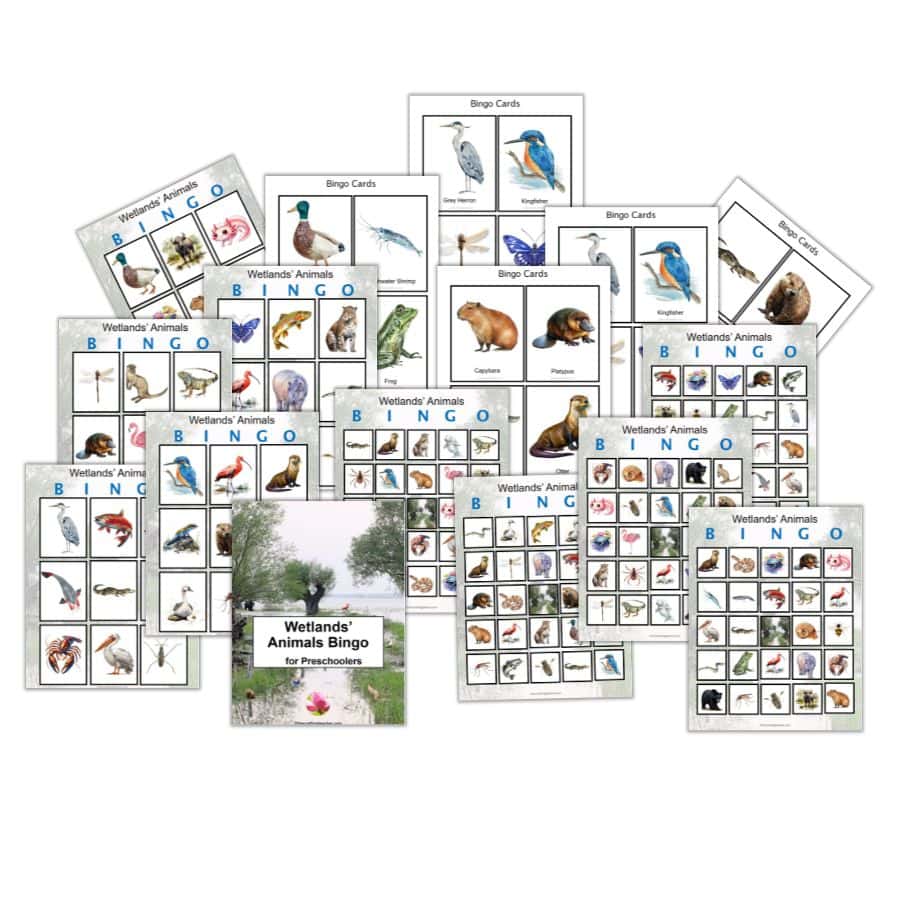
This bingo printable includes two versions with six pages each, one for younger learners and another for more advanced learners. Each card of the simpler version consists of nine pictures. The advanced version also includes 24 pictures on each card. I also included 40 picture cards to show the children which pictures they should mark on their bingo cards. You can get it at the end of this post.
If your preschoolers have been exposed to other bingo games, they can probably work independently. However, new students or children unfamiliar with these types of games will need your guidance. That is why I created two different sets. You will decide which kiddos to group according to their level. It is vital to remember that you want them to feel successful, not frustrated. Otherwise, that experience will result in a negative one, and you won’t be able to accomplish what you are trying to.
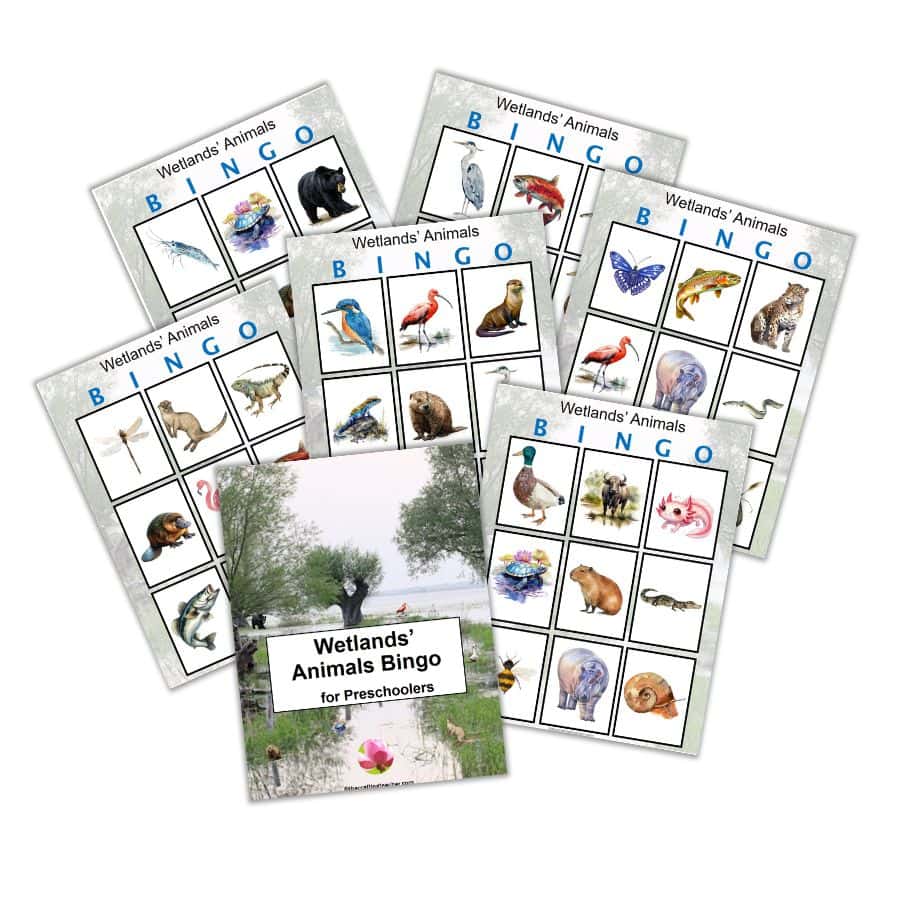
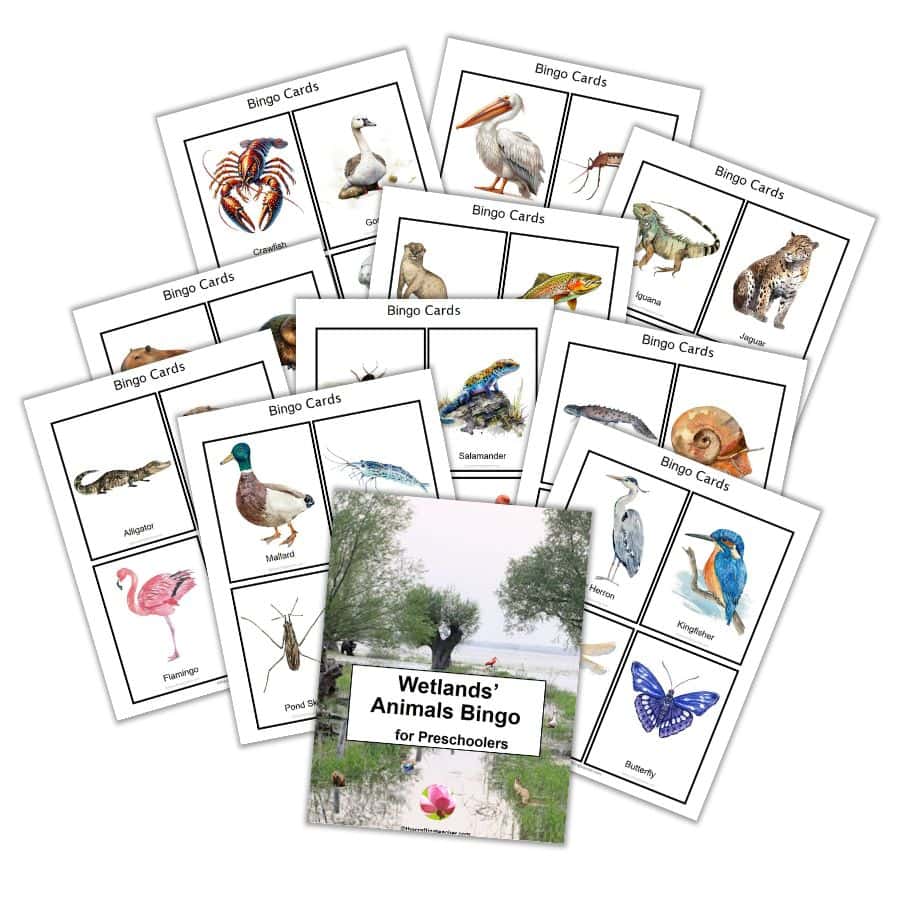
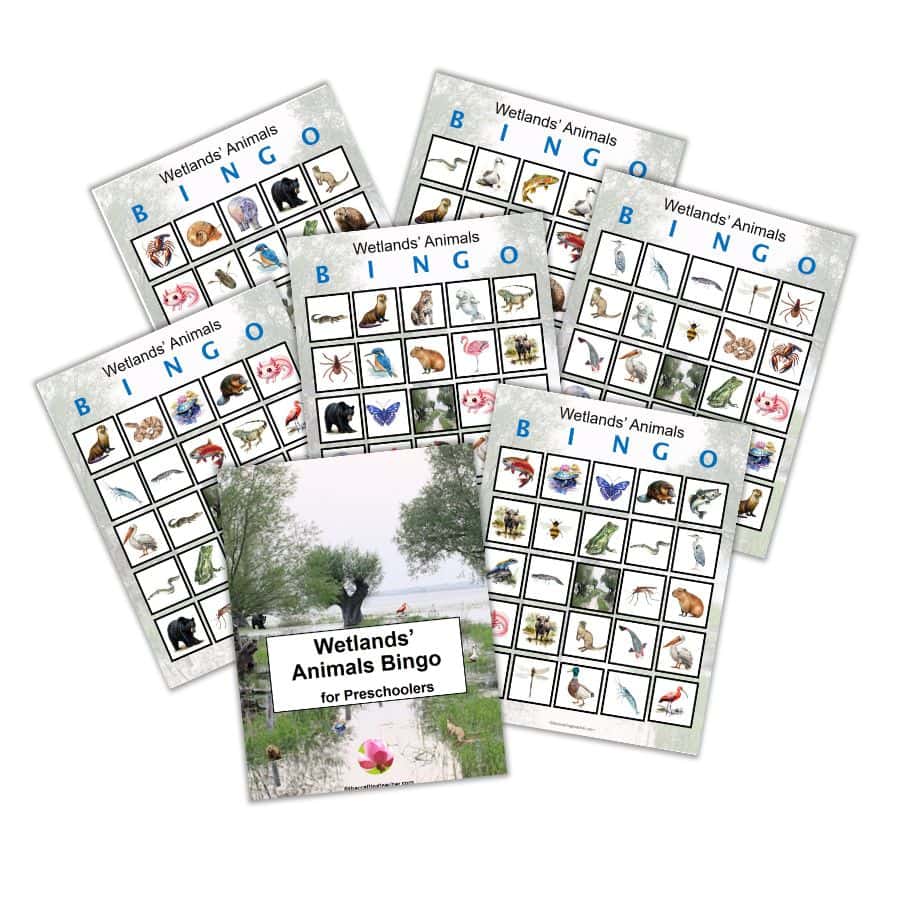
Benefits of This Bingo Game
Like any other bingo game, the Wetlands’ Animals Bingo is not just fun but educational. Some of the most important benefits are:
- Concentration and Memory Development – they need to focus to get it right.
- One-to-One Correspondence and Creating Sets – when they have to match the picture you are showing them with a similar picture on their bingo cards.
- Sensory Development – because they use some of their senses when they hear and see the card you are showing and touch, feel, and manipulate objects.
- Eye and Hand Coordination – placing the bingo chip in the square with the same picture on the card.
- Social Skills – when they take turns and communicate with other players.
- Fine Motor Development – when children move their hands and fingers while playing the game.
- Visual Discrimination – when they look at the pictures and can match it with the one in their cards.
How to Prepare the Wetlands’ Animals Bingo
The process is straightforward. You don’t need a lot of materials, just the following ones:
- FREE Wetlands’ Animals Bingo cards (found at the bottom of this post.)
- Printer.
- White cardstock.
- Bingo chips (these could be mini erasers, resin tiny animals, mini pom-poms, counters, animal buttons, and other items small enough to fit in the bingo cards’ squares).
- Laminator machine and laminator pouches.
- Scissors.
The only thing you need to do is print the Bingo Cards on white cardstock. Then, cut them out and laminate them. I strongly suggest you do that to protect the cards from wear and tear and have them available for your students to play repeatedly.
When not in use, store them in a Ziploc bag for next year.
Playing the Wetlands’ Animals Bingo
To start, each child chooses a bingo card. The teacher or one student (if they are playing as a small group activity) should place the picture cards in an envelope, basket, bag, or any other container where the cards are not visible.
Then, the teacher or child takes a random card out and shows it to the children, and whoever has that picture on his/her bingo card should place a chip on top of it.
The child that fills up an entire row (horizontal, vertical, or diagonal) and yells Bingo!!! wins. If the child is distracted and doesn’t shout Bingo! before another one does, he/she loses.
This game is excellent for strengthening the children’s concentration, memory, one-to-one correspondence, and set creation. Still, it will also keep them busy for a long time while learning without even realizing it.
To extend the game, the winner can be the first to complete their whole card.
I like that this game can be played in the classroom or at home by preschoolers and older children, such as kindergarteners and elementary children. Why not? It is such a matter of having fun.
Extension Activities
The individual cards are labeled with the animals’ names, and you can use them for many other learning activities, taking advantage of the variety in the pictures.
Some of the uses and activities that you can use these cards for are:
- Phonological Awareness Game – Take one of the cards and name the picture emphasizing the beginning sound.
- Letter Recognition – Take one of the cards and name the animal, saying the name of the letter with which its name starts.
- Language Development – Select one of the cards during circle time and invite your preschoolers to talk about the animal in the card.
- Math – Have the children sort the animals by species (mammals, birds, reptiles, etc.), by the number of legs (two, four, or no legs), by the type of body coverage (skin, scales, and fur), and by size (small, medium and large), etc.
- Literacy – During large or small group activity, invite your preschoolers to create a story using the animal in one of the cards while you take dictation to make a class book. Once the story is finished, type the individual paragraphs and paste them on white paper.
Invite the students who didn’t participate in the story to become the illustrators. Once all the pages are done, staple them together, make a cover with a piece of construction, type the title and the names of the authors and illustrators, and laminate all the pages.
Don’t forget to make copies of the book to send home to all the preschoolers.
- Artwork – Place tempera paint and crayons in the art center and invite each preschooler to select a card and use it as an inspiration to draw or paint a picture.
- “The Missing Card” Game is better for small group activity. Take three to five cards and place them on a table. Ask your preschoolers to name the pictures on each card, then have your children close their eyes while you remove one card. Then, ask your preschoolers to open their eyes and tell you which card is missing.
Wetlands-related Books
Don’t forget to read Wetlands’ Animals-related books to your preschoolers. Below are some good ones you can use. You can find them all at your local library, used bookstores, and Amazon. If you want to add some to your collection permanently, click on the titles to go directly to Amazon through my links.
- Fun in the Mud: A Wetland Tale by Sally Bolger is a luxuriously paced tale of the wetlands’ most secretive inhabitants that weaves rich fantasy with fun facts about wetlands.
- About Habitats: Wetlands by Cathryn Sill explores the significant attributes of wetlands and demonstrates their remarkable diversity using examples from around the globe, using simple, easy-to-understand language to teach children what wetlands are, what kinds of animals and plants live there, and how wetlands help maintain the delicate balance of Earth’s environments.
- America’s Wetlands by Marianne Wallace uses full-color illustrations and lively descriptions to help identify wetland types (swamp, marsh, or pond), plants, and animals.
- Song of the Redwing: Voice of the Wetlands by Tish McFadden helps children explore a marsh through the eyes of the red-winged blackbird.
- In the Pond by Aubre Andrus teaches children all about ponds around the world and the animals that call them home, as well as new words and concepts, while helping them expand their understanding of the world.
Pin It For Later
If you are in a rush and don’t have time to read the post and download the printable but want to save it for later, pin it to one of your Pinterest boards to have it available when needed.
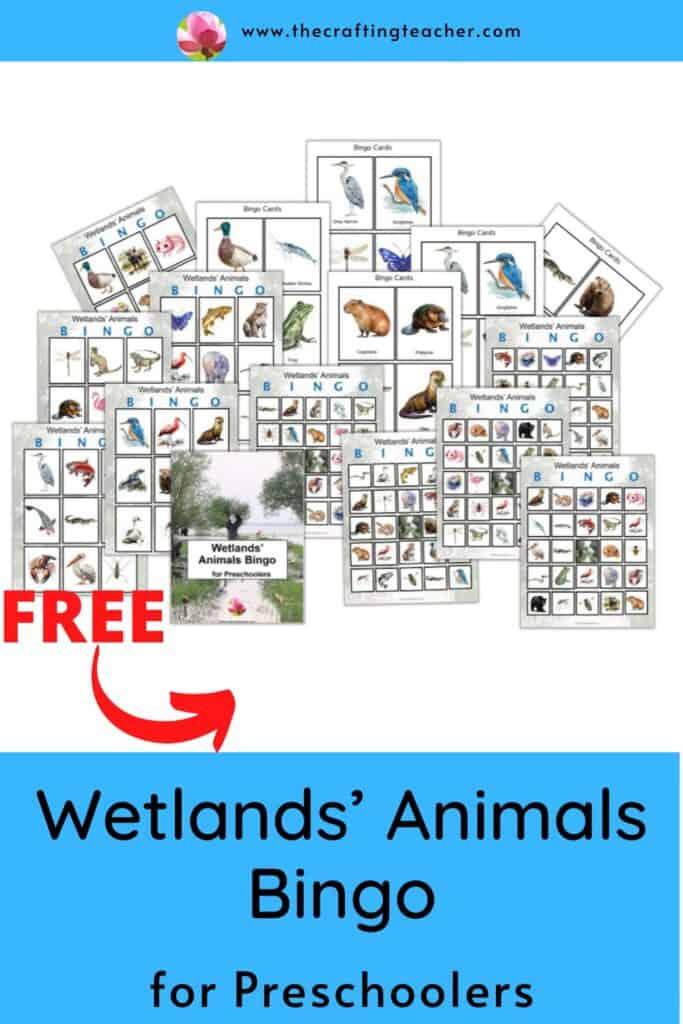
We are losing wetlands three times faster than forests. With that, critically essential ecosystems that contribute to biodiversity, climate control, freshwater availability, and other vital benefits are jeopardized, endangering all kinds of species and our own. We must help raise awareness about wetlands, starting with our preschoolers, to reverse their rapid loss and encourage actions to conserve and restore them.
Don’t forget to grab your FREE Wetlands Animals Bingo printable. Just click on the bottom below to download both versions in one file.
Be happy, safe, and creative. I wish you well.
Love,

P.S. If you want to see an article about making something specific, please let me know, and I will try to write it for you.

